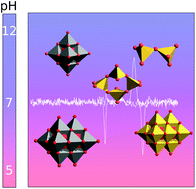Characterization of decavanadate and decaniobate solutions by Raman spectroscopy†
Abstract
The decaniobate ion, (Nb10 = [Nb10O28]6−) being isoelectronic and isostructural with the decavanadate ion (V10 = [V10O28]6−), but chemically and electrochemically more inert, has been useful in advancing the understanding of V10 toxicology and pharmacological activities. In the present study, the solution chemistry of Nb10 and V10 between pH 4 and 12 is studied by Raman spectroscopy. The Raman spectra of V10 show that this vanadate species dominates up to pH 6.45 whereas it remains detectable until pH 8.59, which is an important range for biochemistry. Similarly, Nb10 is present between pH 5.49 and 9.90 and this species remains detectable in solution up to pH 10.80. V10 dissociates at most pH values into smaller tetrahedral vanadate oligomers such as V1 and V2, whereas Nb10 dissociates into Nb6 under mildly (10 > pH > 7.6) or highly alkaline conditions. Solutions of V10 and Nb10 are both kinetically stable under basic pH conditions for at least two weeks and at moderate temperature. The Raman method provides a means of establishing speciation in the difficult niobate system and these findings have important consequences for toxicology activities and pharmacological applications of vanadate and niobate polyoxometalates.



 Please wait while we load your content...
Please wait while we load your content...